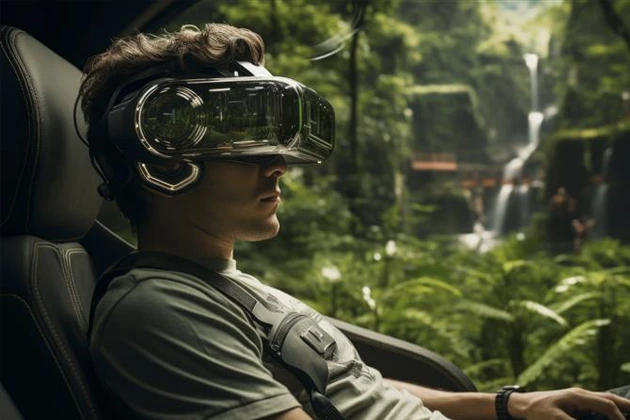In recent years, virtual reality technology has taken the world by storm, with VR headsets becoming a popular commodity. The gaming industry has mostly driven home adoption, and many other fields are also exploring VR. VR applications in the travel industry are also increasingly being adopted to explore their full potential, especially as a marketing tool.
In this article, we will learn about the role of VR in the travel industry.
The History of Virtual Reality
Virtual reality has a history tracing back to the 1960s, when computer scientist Ivan Sutherland created a prototype of a head-mounted display (HMD) that could showcase basic wireframe graphics. Ivan explained the very first idea of VR as “make that (virtual) world in the window look real, sound real, feel real, and respond realistically to the viewer’s actions.” Since then, a trail of research has been conducted, through which we expect to reach Ivan’s “Envisioned Land” in the near future. Below are several examples of research in virtual reality, listed in chronological order:
- Sensorama: Between 1960 and 1962, Morton Heilig developed the Sensorama, a pioneering multi-sensory simulator. This device presented a prerecorded color and stereo film, enhanced by binaural sound, wind effects, scent, and vibrations.
- The Ultimate Display: In 1965, Ivan Sutherland proposed a virtual reality concept. It was an artificial world concept that encompassed interactive graphics, smell, sound, taste, and force-feedback.
- GROPE: The first prototype of a force-feedback system was recognized at the University of North Carolina in 1971.
- VIDEOPLACE: Myron Krueger created artificial reality in 1975.
- VCASS: A Thomas Furness developed in 1982 at the US Air Force’s Armstrong Medical Research Laboratories.
- BOOM: Introduced by the Fake Space Labs in 1989, a small box with two CRT monitors.
- Virtual Wind Tunnel: It was developed in the early 1990s at the NASA Ames Research Center.
- CAVE: A virtual reality and scientific visualization system introduced in 1992.
- Augmented Reality (AR): a technology that presents a virtual world that enriches and does not replace the real world.
Virtual Reality (VR) Technology In a Nutshell
Virtual reality is a technology that enables users to immerse themselves in an artificial, computer-generated, three-dimensional environment and interact with it in real time. This interactive experience allows users to visualize and comprehend complex concepts, explore virtual worlds, and simulate real-life experiences.
Understanding a VR Headset
A VR headset usually requires virtual reality technology, which helps to immerse a user in the digital world. The user is effectively put inside a virtual environment using pictures, sounds, and other physical sensations. It is then passed around and, in some cases, communicated with in other ways. Although VR has a long history, thanks to the high-powered VR set, it has recently come to the forefront of mainstream consumer technology. The features include gaming, immersive video watching, 360-degree image streaming, and more. While many VR applications concentrate on entertainment, technology is also used by advertisers in several exciting ways.
How VR is Changing The Traveling Experience for Travelers?
VR refers to immersive images or videos that allow the viewer to experience the entirety of a scene at 360 degrees. Every part of a place is captured by VR output, unlike a standard video clip taken from a fixed point of view. This VR technology can be used in the travel industry to capture tourist attractions in a creative and immersive manner. It is achieved by using specialized sensors, rigs, and software. The completed content can then be displayed by using a VR headset or a standard computer, or a mobile device.
Many people believe that it is only possible to display VR content on a specialized VR headset, but this is not the case. While, when viewed in this way, VR is more immersive, it can also be viewed on any screen, including mobiles. Businesses operating in the travel industry have, for good reason, been incredibly quick to embrace VR technology. Before they book a hotel room, travel clients typically need a lot of details. For example, this can require them to read descriptions, read reviews of customers, or seek social media feedback. However, a VR company can lower the duration of the process if used smartly.
Applications of VR in the travel industry
Within the travel industry, the use of VR technology is still in its relative infancy. But an increasing number of businesses are experimenting with and finding successful uses for VR headsets. Listed below are some of the critical applications discovered to date inside hospitality companies.
1. Virtual Tours of Hotels: The main advantage is that it enables prospective clients to experience what the hotel looks like before they arrive. It creates more clarity than regular photos. The use of technology for offering virtual tours of hotels is one of the best examples of VR in the travel industry. This ‘taster’ content is typically offered on the distributor’s hotel website and usually requires a VR headset to experience. The VR consists mainly of a single 360-degree picture in several situations. It is often compatible with social media sites and more basic VR technology.
2. Virtual Booking Interface: The use of VR has taken a step forward by several businesses. Virtual Reality companies have a complete booking process, and user interfaces put forward for display through a virtual reality headset. This essentially replaces the need to use a conventional computer mouse to make a hotel or flight reservation. This can provide a much more seamless booking experience when combined with other virtual reality applications. Here, the user can explore different rooms and facilities in a hotel, compare and contrast room styles. The user can also check out local sights and search for critical details or facts, all in the same location.
3. Virtual Travel Experiences: Finally, virtual reality provides the ability for hotels, travel agents, and other companies within the tourism industry. It helps the customers to have a virtual travel experience. This implies that users can explore the key attractions that are likely to bring them to a location.
Future uses of VR in the travel industry
With Virtual Reality, people can enter locations they might not visit in real life using their iPhone or Android phone. The locations may be a sealed-off heritage site or environments with environmental fragility where no one is allowed anymore. In these scenarios, for defensive purposes, VR apps may be the only way. Disabled individuals and senior individuals can also use VR travel. As their disabilities do not allow them to go sightseeing on their own, the sights are brought to them through the glasses.
With a reputation growing rapidly in the business media, The CEO Views is making a position of its own as a media publication. This business publication aims to connect industry peers and entrepreneurs through its high-quality articles, blogs, and profile features.










